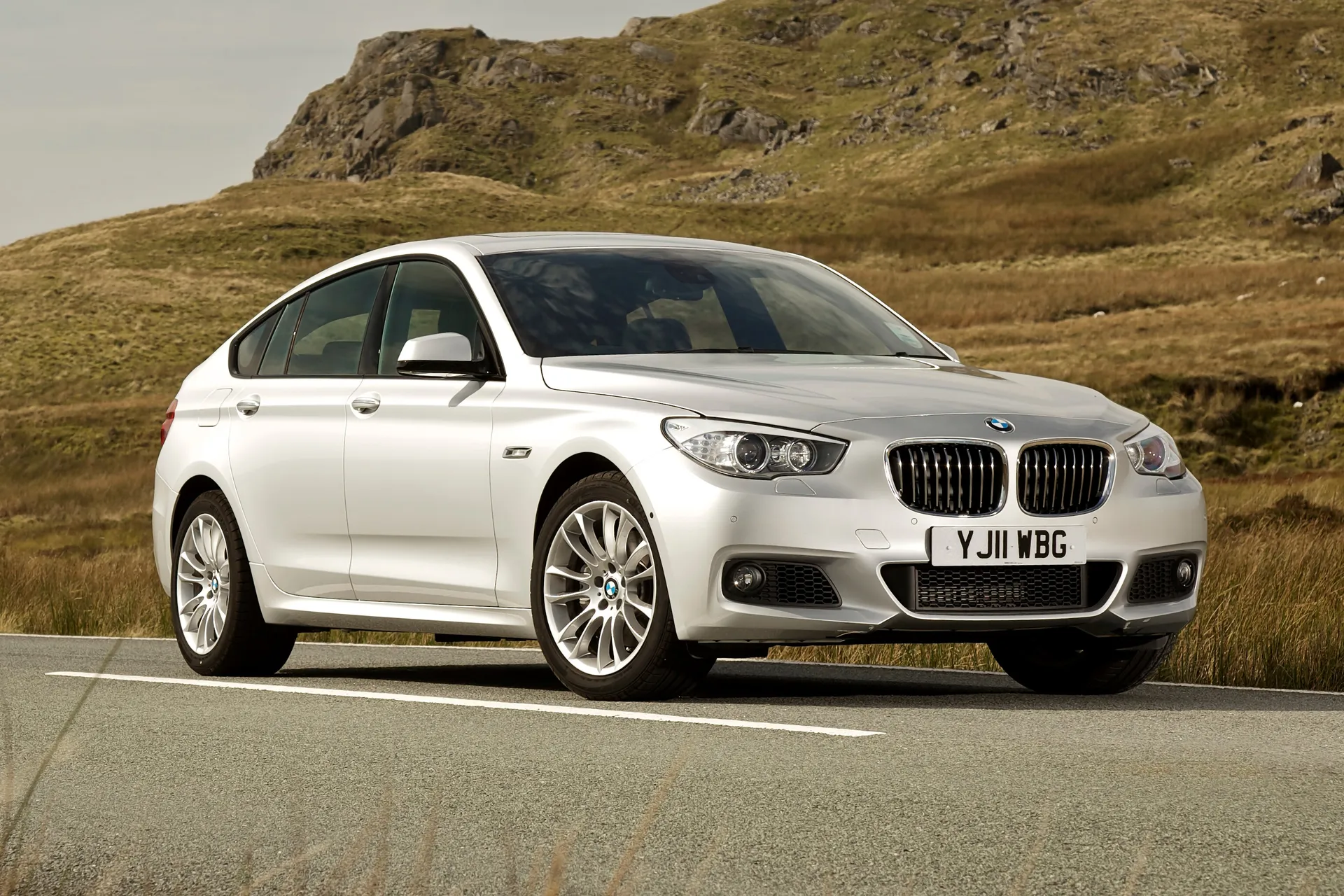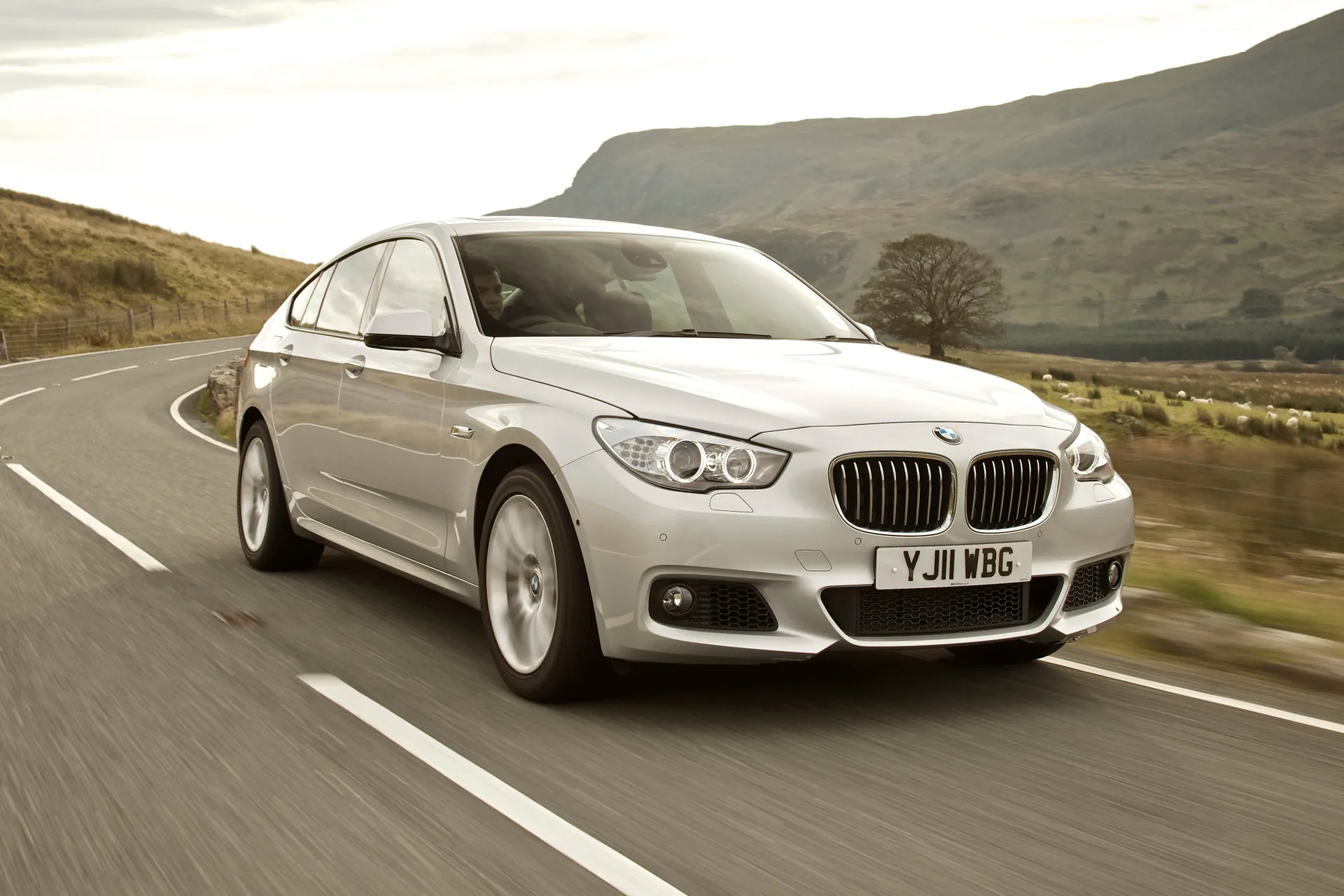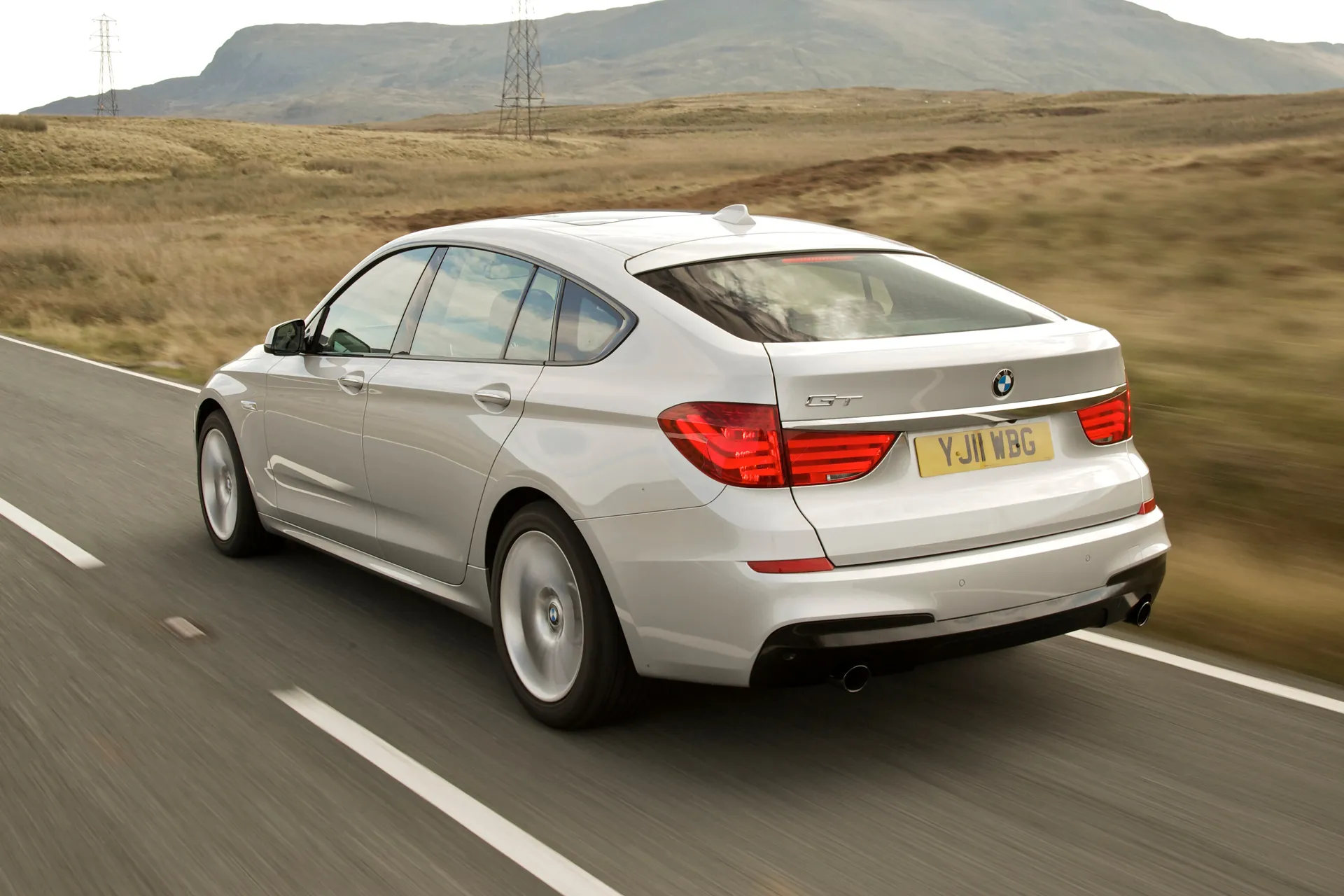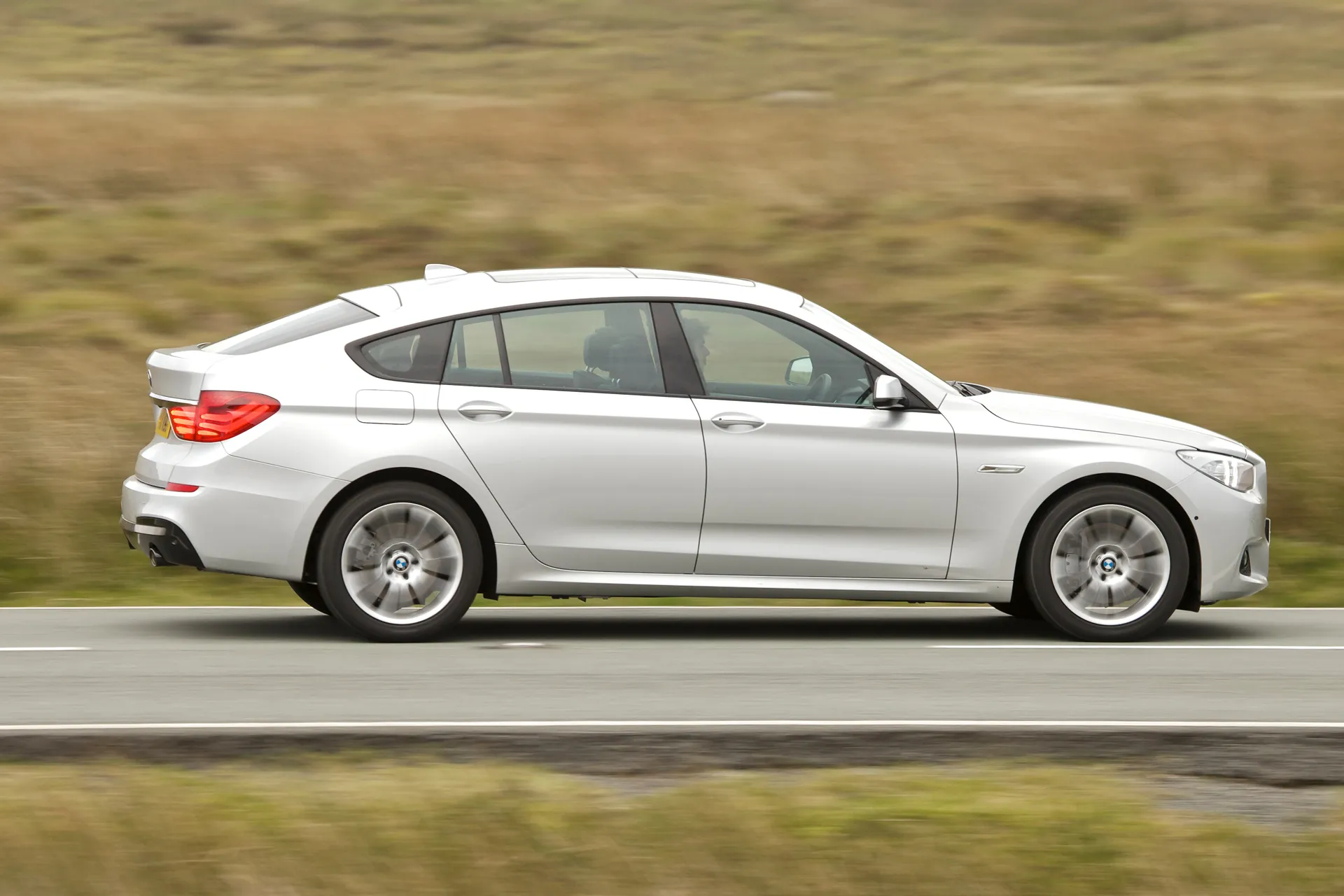BMW 5 Series GT (2009-2017) Review
Written by Andrew Brady
Quick overview
Pros
- Vast cabin space
- Versatile boot
- Excellent engines
Cons
- Large size makes parking a chore
- Running costs
- Looks not to all tastes
Overall verdict on the BMW 5 Series GT
"In this BMW 5 Series GT review we are looking at yet another attempt by the German manufacturer to create a new niche. With the 5 Series saloon and Touring models well established and selling by the thousands, BMW decided that something in between the two was required. The result was the BMW 5 Series GT, somewhere between a hatchback and a fastback with big interior space and frankly oddball looks. Unsurprisingly it was not a hit with buyers."

This mash up of different styles was supposed to make the BMW 5 Series GT appeal to a broad selection of customers. However, they already had the BMW 5 Series saloon and 5 Series Touring, 6 Series coupe, 7 Series luxury car and the X5 and X6 to pick from, not to mention the various SUVs from other premium brands including Porsche. This made the BMW 5 Series GT a tough sell and the numbers bore this out. We'll explain all in our BMW 5 Series GT review.
However, the BMW 5 Series GT is not without its charms and those who looked past the slightly awkward exterior styling that was never the best expression of the original Bangle-era ‘flame surfacing’ experiment were in for an opulent treat. Just as Mercedes had discovered with its gawky R-Class, if you could get people to sit in and drive the BMW 5 Series GT, they would be impressed with its space, comfort and versatility.
While it's called the BMW 5 Series GT, it's more a cross between the luxury BMW 7 Series saloon and the X5. It's also bigger than it looks at five metres long, but the coupe profile helps to disguise the sheer size of it. The exterior styling divides opinion and it's certainly not what you'd describe as a traditionally attractive shape, but it does stand out from the rest of the BMW range, even if it does look unfortunate from certain angles.
It's when you get inside that the BMW 5 Series GT really starts to make sense. It has amazing space for four or five adults with acres of rear legroom and superbly comfortable seats. And then there's the clever twin-opening boot which can operate like a standard saloon boot, or open up larger like a hatchback. If you want to carry four adults - and a large amount of luggage - in supreme luxury, the BMW 5 Series GT is a perfect choice.
And this is where it's really at home - long distance cruising. The ride is smooth and quiet, and you have all the technology and luxury kit you could wish for in a car of this era.
BMW also didn’t stint when it came to the engine line-up. There was an entry-point 520d model, but most buyers ignored this and head straight to the 530d and 535d versions for their greater pace. Buyers could also choose the rapid 535i and 550i petrol models, though these found fewer takers outside of the USA due to their appetite for unleaded.
So, the BMW 5 Series GT is an unusual mixture of styles and influences. However, they do work when you’re inside the car and want masses of space for people and luggage. Just don’t expect it to handle with the same panache as a BMW 5 Series saloon.
If you're looking for the classic version, you need our BMW 5 Series review.
Is the BMW 5 Series GT right for you?
The BMW 5 Series GT was perhaps a little ahead of its time as it pre-dated the current trend for crossover vehicles. This makes it a good bet now, especially if you want a bit of luxury and exclusivity in your life as you drive.
Take the SE and you get almost everything you could ever want in a luxury car, including heated leather seats, climate control and a panoramic glass sunroof. However, the Executive adds a two-seat rear bench in place of the three-seater sofa for an even more limousine-like feel. The M Sport has firmer suspension and exterior body kit, while Luxury and Modern versions arrived with the 2013 facelift.
Whichever trim you choose, BMW loaded all BMW 5 Series GTs with big alloy wheels, all-round parking sensors, automatic headlights and wipers, smartphone connectivity, and its iDrive control. As a result, choosing the right BMW 5 Series GT for you comes down to colour and trim combination and engine choice as much as anything else.
What’s the best BMW 5 Series GT model/engine to choose?
The BMW 5 Series GT in 520d form makes sense if you want this sort of comfort but without frightening fuel bills. However, this version errs on the slow side, so we’d look more towards the six-cylinder turbodiesel 530d and, in particular, the swift 535d. The 535d is a twin-turbo version of the 3.0-litre six-cylinder diesel and has a useful extra kick when accelerating, which will be appreciated in the weighty BMW 5 Series GT. All have an eight-speed automatic gearbox, so all are smooth and easy to drive.
The petrol 535i is a good alternative if you’re not a diesel fan, while the 550i is silky smooth but heavy on fuel. Choose the 550i SE and it comes with its own unique specification, but most BMW 5 Series GTs will be in either SE or Executive trims.
What other cars are similar to the BMW 5 Series GT?
Aside from BMW’s own X5 and X6 models that bookend the 5 Series Gran Turismo, the only truly direct rival the GT ever had was the Mercedes-Benz R-Class. This Mercedes had its looks improved with a facelift and it always offered a huge amount of cabin space for up to seven passengers plus luggage. There’s also a wide engine range, but it doesn’t match the BMW for its handling.
Audi’s Q7 is the only other car in a similar ballpark to the BMW 5 Series GT. However, while the Audi is vast on the outside it feels too small on the inside to get on terms with the luxury of the BMW. You could also consider the A7 Sportback but it doesn't have the same space as the BMW 5 Series GT.
Comfort and design: BMW 5 Series GT interior
"Given that BMW based the BMW 5 Series GT on the 7 Series platform rather than the Five’s as the name might suggest, it’s a given there is a massive amount of space and comfort provided for the driver. In essence, sitting behind the steering wheel of the GT is like being in a Seven but with a raised position that gives a better view to the front and sides."

Rear vision is hindered to some extent by the sweep of the rear tailgate and pillars, but for reversing there are parking sensors to help out.
Even the SE models come with partial electric adjustment for the front seats, so you don’t have to scrabble about to find the ideal driving position. The steering wheel also adjusts for height and reach, so along with the masses of headroom and space for shoulders and legs you will quickly find a comfortable seating set-up. It’s worth noting the headroom in the BMW 5 Series GT is not compromised even though the car comes with panoramic glass sunroof as standard.
On longer drives, you will be very glad of the seat’s well padded cushions that offer just the right amounts of give and support to keep you from fidgeting or aching.
The main instrument binnacle is clear to read and the central infotainment screen is big enough to take in at a glance. Unlike more modern systems, it’s integrated into the dash rather floating above it, but this has the advantage that it’s shaded from glare off the sun.
Quality and finish
As you'd expect of a BMW pitched at this level of luxury, the quality of the interior is impeccable and it has a truly opulent feel to it. From all the high-grade materials used to the feel of the switches and buttons, there are certainly no corners cut here.
Where some BMW models from lower in the company’s pecking order can have plastics that feel a little thinly padded, everywhere your hands come into contact with the BMW 5 Series GT is thickly covered in top class materials. The standard Dakota leather upholstery is the same as found in other 5 Series models, so it’s soft, supple and sumptuous.
All of the controls work with well damped, accurate actions that further lend the BMW 5 Series GT’s interior a feeling of 7 Series luxury. It’s a very pleasing place to be and imparts a feeling of harmony that not many large SUVs can rival.
It's easy to get on with too thanks to a stylish but simple layout. The main stereo and sat nav are controlled through the iDrive dial next to the gear lever, so the main dash isn't cluttered with buttons. There are shortcut buttons to access your most vital menus and pages quickly, while the steering wheel control buttons also have a classy sensuousness that marks out the BMW 5 Series GT from near competitors.
Infotainment: Touchscreen, USB, nav and stereo in the BMW 5 Series GT
At its launch, the BMW 5 Series Gran Turismo’s iDrive infotainment was cutting edge stuff. It was further upgraded with the car’s 2013 facelift when the Professional Navigation sat-nav was made standard on all models other than the 520d. There was also more connectivity introduced at this point to make accessing internet services easier.
All of the 10.2-inch infotainment screen’s functions are accessed using the rotary iDrive controller set down by the gear lever. It’s easy to get at and use thanks to well defined clicks as you turn it. It behaves like a computer mouse and is quickly learnt. This is just as well as the screen is not touch sensitive, which is not an issue as it’s too far away from the driver even if it was a touchscreen.
The display itself is easy to read on the move and shows information such as sat-nav directions in a clear manner. There are also shortcut buttons on the centre console beneath the infotainment screen to make it quick and simple to access your favourite menus or pre-set sat-nav destinations.
Space and practicality: BMW 5 Series GT boot space
Compare the BMW 5 Series Gran Turismo to almost any other luxury car this side of a Range Rover and they all pale by comparison when it comes practicality. This is largely thanks to the sheer size of the BMW 5 Series GT and how much space is given over to its passengers.
Stretching out in the back of the BMW 5 Series GT is much like sitting in the back of a 7 Series. There is more than ample legroom for even the tallest passenger, and the front occupants won’t have to move their seats to accommodate them. In the Executive model, there are two individual seats rather than a three-seat bench, which is not a major problem as the SE’s rear seat base has a noticeable hump in it that makes it less than comfy for anyone to sit on for very long. However, the SE versions do come with three-point belts for everyone in the rear.
One downside for the BMW 5 Series GT’s rear passengers is headroom is not quite as generous as it is in, for example, a 7 Series. This is due to the sweep of the roof line, but only taller passengers will really notice this. In two-seat format, there’s more than ample elbow room.
At the rear of the BMW 5 Series GT is one of its major party pieces as the tailgate can open in two different ways. Use the lower section on its own and the aperture still allows decent access to the luggage space while keeping the cabin isolated from any chilly blast of air. Or, you can open the entire tailgate as a hatchback to allow for much easier loading and unloading of bigger cases.
With the rear seats in place, there’s 440-litres of cargo room, which is not as much as you’ll find in a BMW 5 Series saloon, but with the back seats simply pushed forward and flat you can release up to 1700-litres of carrying capacity. Handily, folding the rear seats is accomplished by pulling on just one handle to bundle the whole rear seat forwards, which is a neat touch to save time and hassle.
The BMW 5 Series GT dimensions are 4998mm long, 1901mm wide and 1559mm tall.
Handling and ride quality: What is the BMW 5 Series GT like to drive?
"Thanks to its rear air suspension, which maintains a consistent ride height whatever the road conditions, the BMW 5 Series GT deals well with rough surfaces, even with a full load of passengers and luggage."

All models have Drive Dynamic Control, which is a system that lets you change the suspension stiffness, steering feel and gear changes. There are three pre-set modes, consisting of Normal, Sport and Sport Plus, while a further system called Adaptive Drive was available as an option that added a Comfort setting with a softer ride.
In normal mode, the BMW 5 Series GT can feel a little soft and isn't as agile as the contemporary 5 Series, with its considerable weight more obvious due to the higher-sided styling. It corners with good composure, but the steering could do with more feel. However, in Sport mode it feels very different and is far flatter on bends with quicker steering.
Don’t be fooled into thinking the BMW 5 Series GT is the last word in driving dynamics and it’s worth bearing in mind this is a car based on the 7 Series rather than the 5 Series. As a consequence, its focus is much more on delivering a cushy limousine-like experience rather than something with sporting bent. Even so, the BMW 5 Series GT brings its own satisfactions when you’re behind the steering wheel.
There's always plenty of grip and at autobahn speeds the BMW 5 Series GT feels amazingly stable. This is where it’s truly in its element and lives up to the Gran Turismo name by wafting from one end of the country to the other in considerable luxury, comfort and calm. The brakes are responsive too, although it can pitch and dive a little under sharp braking.
What engines and gearboxes are available in the BMW 5 Series GT?
Every BMW 5 Series GT comes with an eight-speed automatic gearbox that’s well suited to the car’s long-legged nature and engine line-up. Initially there was one diesel available - the punchy 530d which produces 245PS, later upgraded to 258PS. It’s incredibly smooth, delivering good low-down pulling power along with fuel economy for a car this size.
It's certainly the most obvious engine to go for as it's such an easy car to drive with strong performance where it counts. It also has the edge over the 535i even though the petrol uses twin turbochargers to boost power to 306PS, giving it a swift 0-62mph time of 6.3 seconds that’s around half a second faster than the 530d.
The other petrol engine is a 444PS twin turbo V8 in the 550i. It’s a 4.4-litre engine and thunderously quick, with a great rumbling engine note and makes a perfect top of the range version, albeit with correspondingly high running costs.
In July 2010, the 535d model was added and usurped the 530d as the best engine in the line-up. It's the same 3.0-litre diesel, but with twin-turbos to increase maximum power to 315PS. The extra power makes quite a difference in all conditions.
The entry-point 520d was launched in mid-2012 with 184PS and should be a clever choice, but it doesn’t have the power to match the weight of the 5 GT, even if it is the most economical version.
Refinement and noise levels
The BMW 5 Series GT is designed primarily for long distance travel and in this respect it excels like few others. There's barely any wind or road noise, it's immensely refined and rides very smoothly.
The 530d and 535i GTs have standard 18-inch alloy wheels with runflat tyres that give a far more cosseting quality than those used to earlier BMWs on this type of tyre would believe possible. Even so, there is still a slight firmness on city streets where low-speed ruts and juts in the surface can be felt in the cabin. This isn’t to say that the BMW 5 Series GT is uncomfortable or unsettled, but it’s definitely happier when bowling along at motorway speeds where the suspension is more settled.
All of the engines are hushed when cruising and the only real noise you’ll ever hear from them is if you demand full-blown acceleration at any point as the slick eight-speed automatic gearbox kicks down a gear or two. The 520d model can begin to feel a little strained when overtaking at higher speeds, but otherwise this BMW is supremely insulated from all sources of noise and commotion.
Safety equipment: How safe is the BMW 5 Series GT?
As a flagship model in a similar mould to the 7 Series when it was launched, the BMW 5 Series GT came with every bit of safety kit the company could muster at the time. This meant twin front, side and curtain airbags on all models, along with Dynamic Stability Control Plus ESP. There were also front and rear parking sensors across the range, along with automatic headlights and wipers.
The BMW 5 Series GT was not tested by Euro NCAP for its crash resistance, but it’s fair to say it will be similar to the 5 and 7 Series in this respect, so very protective of its occupants.
BMW didn’t offer the BMW 5 Series GT with four-wheel drive as an option for European buyers, but you could order a head-up display that projects important information on to the windscreen. This includes speed and sat-nav directions, and saves the driver from looking away from the road. Adaptive cruise control was another option to maintain a safe distance from the vehicle in front.
The BMW 5 Series GT came with bi-xenon headlights as standard on all models and this also included daytime driving lights and Adaptive Headlights. These could give a variable spread of beam to give maximum illumination without dazzling oncoming cars, and they also featured Bending Lights as an option to help see further into corners. Other safety options encompassed Lane Departure Warning, Speed Limit Info, Side View, and even Night Vision to spot objects in the dark and show them on the infotainment screen.
MPG and fuel costs: What does a BMW 5 Series GT cost to run?
"The most cost-effective BMW 5 Series GT model is the 520d that came with an official combined economy of 51.4mpg in pre-WLTP testing. A look at Real MPG figures shows this works out at a genuine 40.3mpg, which is reasonable for a car of this scale and opulence."

The 530d has a claimed 48.7mpg that works out to 38.3mpg in Real MPG conditions, which is on a par with most large diesel-engined SUVs.
At the other end of the scale, the 550i claimed 30.7mpg but returns real-world consumption in the mid-20s in mixed driving conditions.
How reliable is a BMW 5 Series GT?
So few examples of the BMW 5 Series GT were sold in the UK that it doesn't feature in the HonestJohn.co.uk Satisfaction Survey, but if you look at the BMW 5 Series and BMW 7 Series as representative, the former scored an underwhelming 8.66 out of 10 while the latter was much more impressive at 9.75 out of 10.
As a brand BMW finished a distinctly average 20th out of 30 manufactures overall, just one place ahead of Audi and well behind Mercedes-Benz in 13th.
Insurance groups and costs
There is quite a spread of insurance rankings for the BMW 5 Series Gran Turismo, starting with the 520d SE as the cheapest to get cover for. It starts in group 33, which is much the same as for a mid-spec BMW 5 Series saloon.
Move up to the more potent 530d version and it jumps 10 bands to sit in group 43. Move to a 550i M Sport model and your cover will be calculated on a minimum of group 46 rating that means a pricey premium even for those living in low-risk area and with the car safely parked off the road overnight.
VED car tax: What is the annual road tax on a BMW 5 Series GT?
With almost all BMW 5 Series Gran Turismo models being registered before 31 March 2017, their Vehicle Excise Duty is calculated solely on their carbon dioxide emissions. This means the 520d with its 144g/km will pay £165 per year for road tax.
The 530d attracts a yearly tax levy of £265, while the 535d comes in at the same rate for 12 month’s taxation. However, the 550i will set you back a rather heftier £360 per year for road tax.
How much should you be paying for a used BMW 5 Series GT?
"Look for a BMW 5 Series GT from the start of the model’s life and you’ll find examples with 90,000 miles on the clock for around £7,000. This will get you a 530d in SE or Executive trim and with a complete service record."

Move up to the rare 550i and you’ll be hunting from around £10,000. The much more abundant 520d can be found for similar money for a seven-year old example.
Choose a late version of the BMW 5 Series GT and a 2017 535d M Sport can be yours from around £25,000 with approximately 40,000 miles on the clock. Look for a 530d version of this model at the same age and mileage and you won’t find one cheaper, but there is a much broader selection to choose from as the 530d was a more popular model when it was new.
Trim levels and standard equipment
BMW started the BMW 5 Series GT line-up with the SE that has 18-inch alloy wheels, cruise control, all-round parking sensors, and automatic headlights and wipers. The interior boasts leather upholstery and heated front seats with electric seat adjustment, multi-function steering wheel, iDrive and 10.2-inch infotainment screen, and a panoramic glass sunroof.
The BMW 5 Series GT SE upgraded this with 19-inch alloys, driver’s seat memory, and electric adjustment for the steering column. BMW 5 Series GT Executive models gained Comfort front seats and two individual rear chairs with electric adjustment, and all four seats are heated.
The BMW 5 Series GT M Sport model arrived in late 2011 with 19-inch wheels, sports front seats, M aerodynamic body kit, firmer suspension, M steering wheel, anthracite dark headliner, and glossy Shadowline exterior trim. In mid-2013, the BMW 5 Series GT Luxury and Modern versions were added, with specifications based on the SE and slight trim variations to broaden the range.
Ask the heycar experts: common questions
Is the BMW 5 Series GT a good car?
What does the GT mean on a BMW?
What is the price of the BMW 5 Series GT?
Get our latest advice, news and offers
Keep me updated by email with the latest advice, news and offers from heycar.
By submitting you agree to our privacy policy



